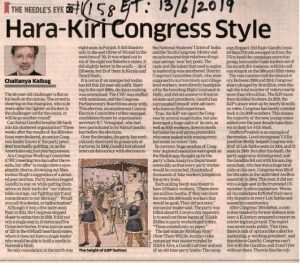The Needle’s Eye
Hara-Kiri Congress Style 
Published date: 13th June 2019, The Economic Times
View PDFThe 48-year-old challenger is flat on his back on the canvas. The crowd is cheering on the champion, who is 20 years older but lighter on his feet. Is the challenger out for the count, or will he go another round?  
Can Rahul Gandhi breathe life back into his shattered organization? Three weeks after the results of the 2019 elections were declared, no senior Congress leader knows if the party president is actually quitting, or, as the Americans say, just playing possum.
At a Congress Working Committee (CWC) meeting two days after the results, his ‘offer’ to resign drew a sycophantic chorus, drowning out Manmohan Singh’s suggestion of a detailed post-mortem. Party leaders begged Gandhi to stay on while patting themselves on their backs for “our indomitable courage, our fighting spirit and commitment to our ideology”. Would you call this denial, or hallucination?¬†¬†
Although it won a few more seats than in 2014, the Congress stepped closer to extinction in 2019. It did not win a single seat in 13 states and five Union territories. It won just six seats out of 225 in the 10 Hindi heartland states, where it does not have a single leader who would be able to hold a candle to Narendra Modi.  
Its only consolation in the north was eight seats in Punjab. It did disastrously in the east (three of 63) and in the west (two of 76). It was wiped out in six of the eight northeastern states. It did slightly better in the south Р26 of 128 seats, but 23 of them in Kerala and Tamil Nadu.  
It is not as if an unexpected toofan has hit this 134-year-old outfit. Starting in the mid-1990s, decision-making was centralized. The CWC was stuffed with nominees, and the Congress Parliamentary Board was done away with. This selection, an acquiescent Central Election Committee rubber-stamped candidates chosen by organization secretary KC Venugopal, who had been parachuted in by Rahul Gandhi just before the elections.  
Over the decades, the party has meticulously destroyed its grassroots structures. In 2008, Gandhi introduced internal democracy with elections to the National Students’ Union of India and the Youth Congress. Money and muscle ensured that relatives of regional satraps ‘won’ key posts.¬†The rank-and-file talent that used to aspire to leadership was smothered. District Congress Committee chiefs, who were supposed to nurture block and village-level workers, were directly handpicked by the brooding High Command in Delhi, and did not answer to frustrated state unit presidents. Gandhi has surrounded himself with advisers who have no field experience.¬†¬†
True, the BJP outspent the Congress by several magnitudes, but also leveraged a huge cadre of its own, as well as RSS workers, down to booth karyakartas and panna pramukhs who were tasked with wooing every last name on voters’ lists.¬†¬†
In contrast, huge swathes of Congress’ depleted resources were spent on the Shakti app, thought up by the party’s Data Analytics Department ostensibly so that every party worker would be connected. Hundreds of thousands of fake workers jumped on the gravy train.¬†¬†
Each polling booth was meant to have 10 Shakti workers. “There were one million booths. If they can show me even 200,000 booth workers that would be good. They did not exist,” one senior leader said. The party was billed about ‚āĻ1.5 crore a day apparently to send out three bursts of 75 lakh SMSes to party workers and voters. “These existed only on paper.”¬†¬†
The last-minute ‘Ab Hoga Nyay’ (Now There Will Be Justice) video campaign was masterminded by Nikhil Alva, a Gandhi adviser and son of an old-time party leader. The campaign flopped. Old Rajiv Gandhi loyalist Sam Pitroda swooped in from the US to head the campaign execution group, but couldn’t take his foot out of his mouth (for instance, with his callous remark on the 1984 anti-Sikh riots).¬†
The vote numbers tell the dismal story. Between 2009 and 2014, Congress’ share plunged by 50 million, even though the total number of voters rose by more than 100 million. The BJP more than doubled its share. In 2019, the BJP’s share went up by nearly 60 million votes. Congress has barely crawled back to its 2009 numbers. This means the majority of the new, young voters added over the past decade have thrown in their lot with Modi.¬†¬†
Andhra Pradesh is an example of the erosion. Local strongman Y S Rajasekhar Reddy helped Congress win 29 of 42 Lok Sabha seats in 2004, and 33 seats in 2009. But after his death, the party apparatus disintegrated, and the Gandhis fell out with his son Jaganmohan, who has won a huge landslide on his own. Congress won 185 of the 294 seats in the undivided Andhra assembly in 2004. This year, it did not win a single seat in the truncated 175-member Andhra legislature. Worse, all its candidates forfeited their security deposits in every Lok Sabha and assembly constituency.  
After Congress’ 2014 defeat, a committee headed by former defense minister A K Antony prepared a report on retrieving lost ground. The report was never made public. This time, there is talk of options like collective leadership, a ‘working president’, and deputies to Gandhi. Congress can’t live with the Gandhis, and it can’t live without them. Therein lies the rub.¬†







